Imagine a world beneath the waves, filled with astonishing creatures and hidden mysteries. The ocean, covering over 70% of our planet, is home to a diverse array of life, from the tiny, glowing plankton to the majestic whales. This blog post is your ticket to explore these wonders with your little ones.
Why learn about sea animals? Because they’re not just fascinating; they teach us valuable lessons about the environment, adaptation, and the importance of preserving our planet. This adventure is not only about fun facts; it’s a journey toward understanding and appreciating the delicate balance of marine ecosystems.
So, whether you’re a kid who dreams of underwater adventures or a parent eager to spark a love for learning in your child, join us as we dive into the deep, exploring 25 incredible facts about sea animals. Let’s embark on this educational voyage together, discovering the secrets of the ocean and the creatures that call it home.
The Amazing Diversity of Sea Life
The ocean is not just a body of water; it’s a thriving, bustling world teeming with life in every drop. This section unveils the staggering variety of sea life, from the colorful coral reefs to the mysterious depths where sunlight dares not reach. Let’s dive into the incredible diversity that lies beneath the waves.
Unveiling the Variety
Fact 1: Scientists estimate that over 1 million species live in the oceans, but the vast majority remain undiscovered. The sea is like a giant treasure chest, continually revealing new wonders to us.
Fact 2: The ocean is home to a multitude of habitats, each supporting its unique life forms. From the warm, shallow waters of coral reefs, which are often called the rainforests of the sea due to their rich biodiversity, to the dark, pressure-filled depths of the ocean trenches, every corner of the sea has life adapted to thrive in its conditions.
Colorful Inhabitants of the Coral Reefs

Coral reefs, vibrant and teeming with life, are among the most visually stunning habitats in the ocean. These underwater ecosystems are not just beautiful; they’re crucial for the survival of many marine species.
Fact 3: Coral reefs cover less than 1% of the ocean floor, but they provide a home for approximately 25% of all marine species. This includes thousands of fish species, hundreds of coral types, and a plethora of invertebrates.
Fact 4: Among reef dwellers, the clownfish and its symbiotic relationship with sea anemones is a fascinating example of marine cooperation. The clownfish finds shelter among the venomous tentacles of the anemone, protected from predators, while it provides the anemone with nutrients through its waste.
The Giants of the Sea
When we think of the ocean’s giants, whales often come to mind, but they’re just the beginning. The sea is home to a variety of colossal creatures, each with its own unique story. This section dives into the fascinating world of the ocean’s largest inhabitants, revealing their secrets and the roles they play in the marine ecosystem.
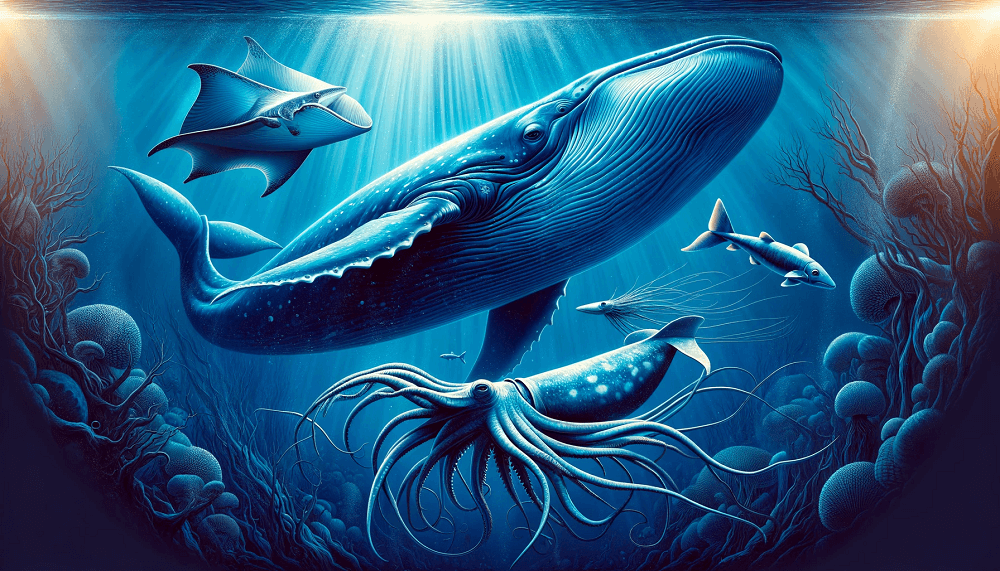
Marvelous Marine Mammals
Fact 5: The blue whale, the largest animal to have ever existed, can grow up to 100 feet long and weigh as much as 200 tons. Despite their immense size, blue whales feed almost exclusively on tiny shrimp-like animals called krill. During the feeding season, an adult blue whale consumes about 4 tons of krill a day.
Fact 6: Whales have complex communication systems, often using songs that can travel for thousands of miles underwater. These songs are not just beautiful; they’re a key part of how whales navigate, mate, and socialize across the vast oceans.
The Deep Sea Giants
The depths of the ocean hide creatures so bizarre and large they seem to belong to another world. Among these deep-sea dwellers, the giant squid and the whale shark are particularly awe-inspiring.
Fact 7: The giant squid, once believed to be a mythical creature, can grow up to 43 feet long. Its eyes are the size of dinner plates, making them one of the largest eyes in the animal kingdom, adapted to detect faint light in the deep ocean.
Fact 8: The whale shark, the largest fish in the sea, can grow up to 60 feet in length. Despite their size, whale sharks are gentle giants, feeding mainly on plankton and small fish by filtering water through their massive mouths.
Mysterious Creatures of the Deep
Beyond the reach of sunlight, in the ocean’s dark abyss, dwell creatures so alien and mysterious, they could rival the inhabitants of another planet. This section unveils the enigmatic world of deep-sea life, where survival means adapting to extreme conditions in innovative ways.
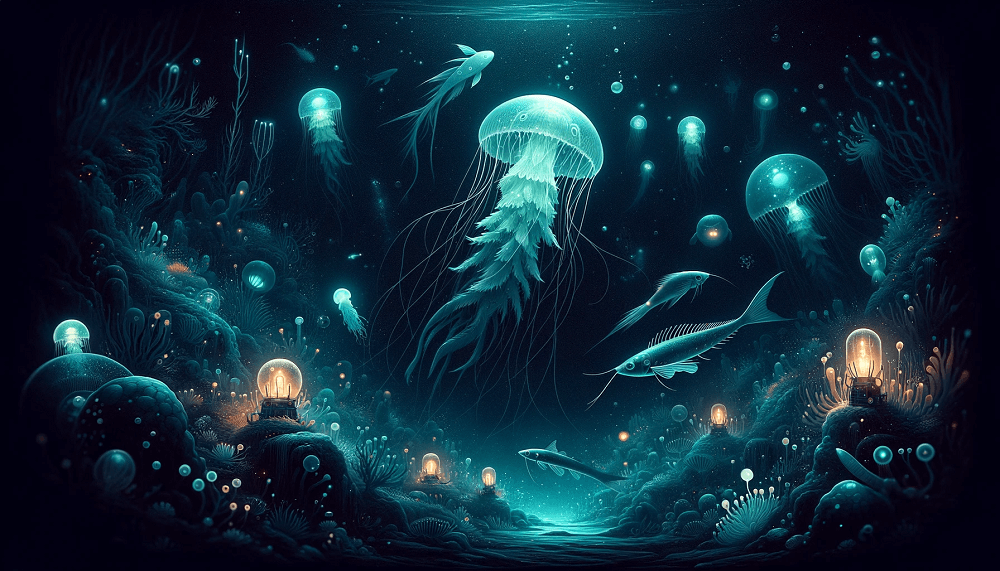
The Elusive Residents of the Ocean Depths
Fact 9: The deep sea is home to some of the most extreme environments on Earth, including hydrothermal vents that spew superheated water rich in minerals. The creatures living here, like the giant tube worm, have developed unique adaptations to thrive in these harsh conditions, relying on chemosynthesis rather than photosynthesis for energy.
ALSO READ – 30 Amazing Animal Facts That Will Fascinate Your Kids
Fact 10: Bioluminescence, the ability to produce light through a chemical reaction, is a common trait among deep-sea creatures. This mesmerizing light show is not just for beauty; it’s used for attracting prey, communication, and camouflage. The anglerfish is a famous example, using a lighted lure to attract unsuspecting victims.
Predators of the Deep
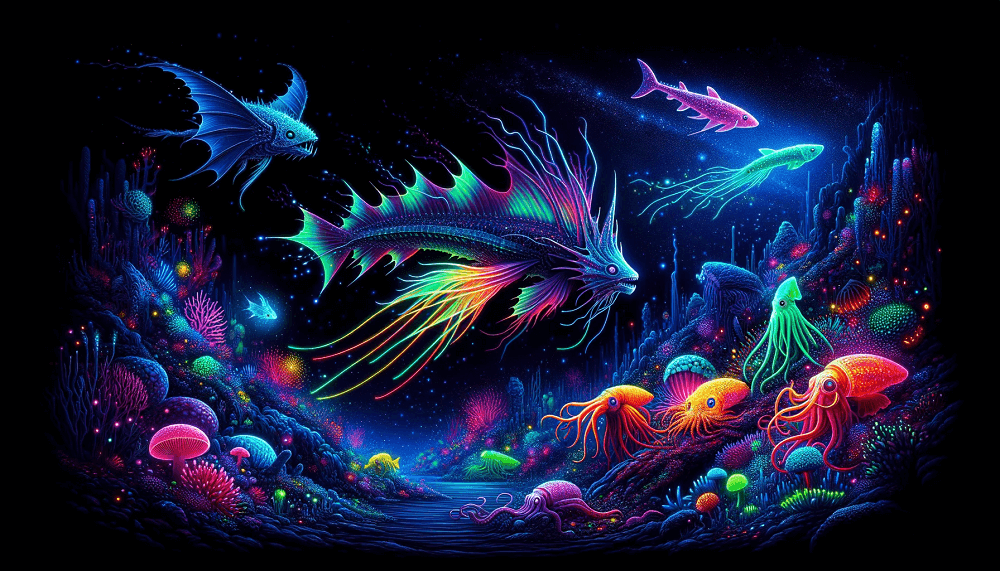
Deep below, where the sun’s rays cannot penetrate, lie predators with fascinating adaptations that make them formidable hunters.
Fact 11: The deep-sea dragonfish, a predator in these shadowy depths, can produce a faint, red bioluminescent glow. This unique ability allows it to see its prey without revealing its presence, as most deep-sea creatures cannot see red light.
Fact 12: Camouflage is crucial for survival in the deep sea. The vampire squid, with its black body and webbed arms, can turn itself inside out to avoid predators, presenting a spiky, intimidating appearance that belies its gentle nature.
Ingenious Adaptations
The ocean’s vastness hosts a theater of evolution, showcasing a cast of characters whose lives are a testament to the ingenuity of nature. In this section, we delve into the remarkable adaptations that enable sea animals to thrive in environments ranging from the sunlit surfaces to the abyssal depths.
Survival in Extreme Conditions
Life in the ocean demands resilience and creativity, and marine creatures are masters of adaptation, finding ways to survive in some of the planet’s most extreme conditions.
Fact 13: Some deep-sea creatures withstand crushing pressures that would flatten most forms of life. The hadal snailfish, residing at depths of over 26,000 feet, thrives under pressures more than a thousand times the atmospheric pressure at sea level, thanks to a gelatinous structure and a unique cellular makeup that prevent it from being crushed.
Fact 14: Salinity, or the saltiness of water, varies greatly across different oceanic environments. The mangrove killifish can live in both fresh and extremely salty waters, an adaptability few fish possess. It achieves this by altering its body’s internal osmotic processes, effectively turning its physiology “on” and “off” to match its environment.
The Unique Diets of Sea Animals
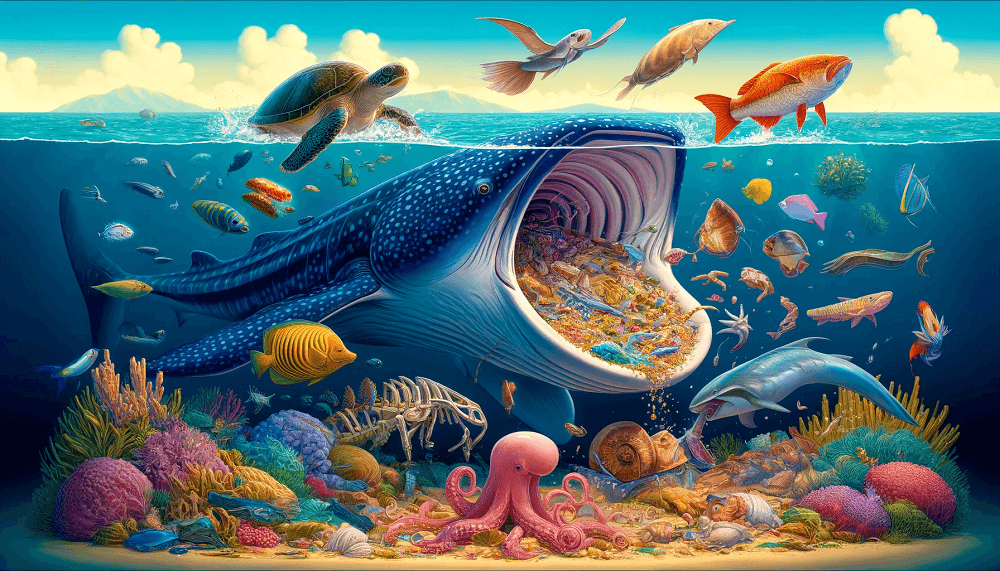
From the microscopic to the massive, every sea creature has a diet as unique as its habitat, contributing to the complex tapestry of marine life.
Fact 15: The diet of marine animals can be as varied as the ocean’s ecosystems. For instance, the leatherback sea turtle feeds almost exclusively on jellyfish, helping to control jellyfish populations. Its mouth and throat are adapted to safely consume and digest these gelatinous creatures, with backward-pointing spines preventing their slippery prey from escaping.
Fact 16: Plankton, though minuscule, form the foundation of the ocean’s food web. The whale shark, despite being the largest fish in the sea, feeds on these tiny organisms by filter-feeding, swimming with its mouth open to collect plankton-filled water, which it then expels through its gills while retaining the nourishing plankton.
The Social Lives of Marine Animals
The ocean is not just a habitat but a community, with complex social networks and communication systems that rival any on land. In this section, we explore the social behaviors and structures that define the lives of marine animals, revealing a world of interaction, cooperation, and sometimes, competition.
Communication Underwater
Marine animals have developed sophisticated methods of communication, relying on sound, light, and even electricity to convey messages across the dark and vast ocean.
Fact 17: Dolphins are among the most socially intelligent creatures in the sea, known for their complex vocalizations and ability to communicate with each other using a series of clicks, whistles, and body movements. These sounds are not just for communication; they also play a crucial role in the dolphins’ echolocation, helping them navigate and hunt in murky waters.
Fact 18: Not all communication in the ocean is auditory. The cuttlefish, a relative of the squid and octopus, communicates through an intricate display of changing skin colors and patterns. These displays can signify aggression, camouflage, or courtship, showing the cuttlefish’s emotional state and intentions.
Reproduction and Lifecycle
The reproductive strategies and lifecycles of sea animals are as varied as the ocean’s depths, with each species finding its unique way to ensure the survival of its lineage.
Fact 19: The lifecycle of a sea turtle is a remarkable journey of survival. After hatching on beaches, young turtles make a perilous trek to the sea, facing numerous predators. Those that survive grow to travel thousands of miles across the oceans, eventually returning to the same beaches to lay their eggs, completing the cycle of life.
Fact 20: Coral reefs, though not animals themselves, are formed by the tiny coral polyps that build them. These polyps reproduce both sexually and asexually, creating vast colonies that serve as the foundation of reef ecosystems. Once a year, in a synchronized event, many coral species release their eggs and sperm into the water en masse, a phenomenon known as coral spawning. This event is crucial for the growth and regeneration of coral reefs, highlighting the interconnectedness of life under the sea.
Conservation and Threats
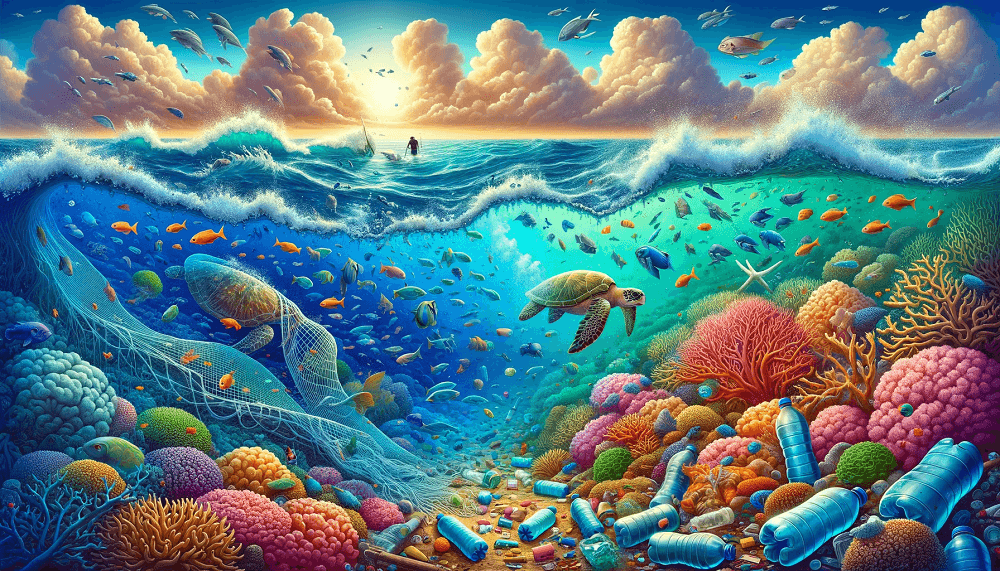
The ocean’s vastness and the richness of life it harbors are under unprecedented pressure from human activities. In this section, we discuss the critical threats facing marine ecosystems and the efforts being made to conserve and protect the ocean’s invaluable biodiversity.
The Fragile Ecosystem
The beauty and diversity of the ocean mask a delicate balance, now increasingly disrupted by climate change, pollution, overfishing, and habitat destruction.
Fact 21: Climate change is leading to warmer ocean temperatures and more acidic waters, conditions that threaten marine life at every level, from the smallest plankton to the largest whales. Coral bleaching, a stress response to temperature changes, is causing widespread damage to coral reefs, vital habitats for a quarter of all marine species.
Fact 22: Overfishing has significantly impacted many fish populations, pushing some species towards extinction. The removal of key species disrupts food webs and can lead to the collapse of entire ecosystems. Illegal, unreported, and unregulated (IUU) fishing further exacerbates this threat, undermining efforts to manage and conserve fish stocks.
Conservation Efforts
Despite these challenges, there are rays of hope. Conservation initiatives worldwide are working to protect marine life and restore the health of the oceans.
Fact 23: Marine Protected Areas (MPAs) have been established in various parts of the world to conserve marine ecosystems. These areas restrict human activities, allowing ecosystems to recover and thrive. The success of MPAs in increasing fish populations and biodiversity is a testament to the resilience of marine ecosystems.
Fact 24: Grassroots conservation efforts are also making a difference. Beach clean-ups, sustainable seafood choices, and educational programs raise awareness and encourage responsible behavior. Innovative technologies, like coral reef restoration projects and anti-by-catch devices, are being developed to mitigate human impact on the sea.
Interactive Learning Opportunities
In the journey to understand and protect our oceans, knowledge is not just power—it’s a pathway to change. This section explores interactive learning opportunities that bring the marvels of marine life closer to both children and adults, fostering a deep, lasting appreciation for the sea and its inhabitants.
Educational Resources and Activities
Engaging with the wonders of the marine world can be a thrilling adventure for curious minds. Here are some ways to dive deeper into oceanography and marine biology, no matter where you are.
Fact 25: Virtual marine biology camps and online resources offer a window into the undersea world for learners of all ages. Websites and organizations like the Monterey Bay Aquarium and the National Geographic Society provide live feeds, documentaries, and educational materials that bring the ocean’s mysteries to your screen.
Tips for Parents: Encourage your child’s interest in marine life with interactive books, games, and puzzles that feature sea animals. Many educational apps combine fun with learning, offering quizzes, virtual aquariums, and even coding lessons themed around ocean conservation.
Exploring Local Marine Ecosystems
If you’re near the coast, visiting tide pools, beaches, or marine sanctuaries can be an excellent hands-on learning experience. Observing marine life in its natural habitat, under the guidance of conservation guidelines, can teach respect for nature and the importance of environmental stewardship.
Citizen Science Projects
Participating in citizen science projects is another way to contribute to marine conservation efforts while learning about the ocean. Organizations like Zooniverse and SciStarter list projects that need help from volunteers, ranging from analyzing camera trap images to monitoring water quality.
Conclusion
The ocean is a vast, living library, with each creature and habitat a story waiting to be told. By exploring interactive learning opportunities and educational resources, we can all become students of the sea, gaining knowledge that empowers us to protect our planet’s most precious resource. Let’s dive into learning, with curiosity as our compass, and inspire the next generation of ocean guardians.

